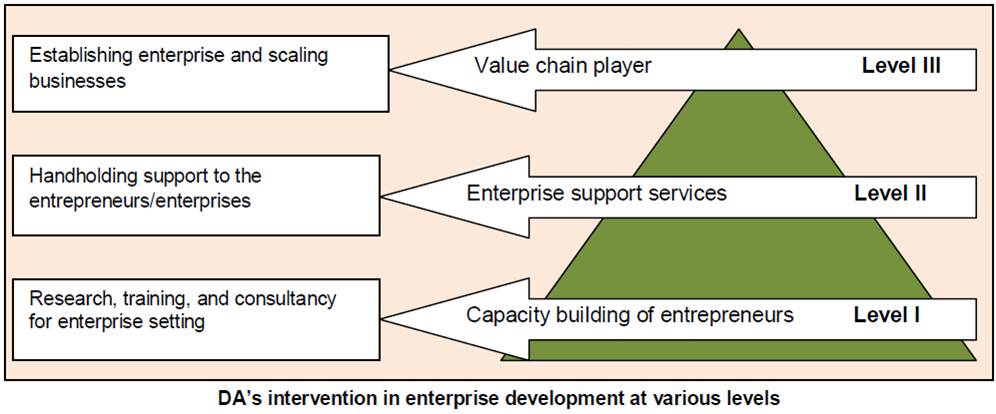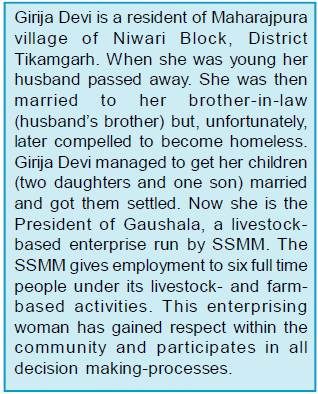|
Economic Empowerment:
Enterprise Creation T he Indian economy is one of the fastest growing economies of the world with a sustainable growth rate of 5 to 8 per cent for the last seven consecutive years. The projections for the growth of the Indian economy look positive and promising. While the GDP curve has been showing an upward trend for a decade now, India continues to remain bound in a complex web of poverty.More than 300 million people in India live below the poverty line, earning less than $2 a day. The condition of rural India is worse than urban India in terms of earnings, which has direct implications on the quality of life. The marginalised rural women are greatly burdened with their domestic responsibilities as well as working on the fields or as daily wage labourers. Lack of enterprise creation across rural India is a big bottleneck in the development of the marginalised communities. At the time of India’s independence, industrialisation was viewed as the engine of growth for the rest of the economy as well as the supplier of jobs that would reduce poverty. By the early 1990s, substantial progress had been made, but industrial growth had failed to live up to its expectations. The Economic Survey of 2011 reports that ‘India’s slowdown in this fiscal year can be attributed almost entirely to weakening industrial growth.’ The emphasis on large-scale, capital-intensive industries created far fewer jobs than the estimated 10 million annual entrants into the labour force required. Hence, unemployment continued to grow. Central to the problem of poverty is the lack of work opportunities. The lack of livelihood options has restricted the poor communities from access to products and services. This, in turn, has limited their development and empowerment. Economic empowerment is generally seen in terms of influence on an individual’s personal development, i.e. influence over economic resources and other decisions pertaining to general welfare of the family. The Development Alternatives (DA) Group is committed to actions that reduce poverty. DA has promoted and facilitated the creation of green jobs and enterprises through its work with poor communities. There is increasing recognition and evidence that private sector development has an important role to play in poverty reduction and human development. DA works closely to incubate and design business models to help the promotion of small enterprises that promote local economic development in its endeavour to socially and economically empower communities. The development of enterprises creates and sustains the jobs necessary for poor people to work and earn the income needed to purchase goods and services. Moreover, these efforts boost the local economy and help reduce regional inequality and stress migration. DA’s work in this sphere can be classified under the following heads: (i) Development of Micro Small and Medium Enterprises (MSMEs) (ii) Building community institutions for enterprise development and (iii) Convergence with the Mahatma Gandhi National Rural Employment Guarantee Act. Development of Micro Small and Medium Enterprises (MSMEs) Micro small and medium enterprises (MSMEs) play a major role in economic development and overcoming poverty. Contributing to around 22 per cent in the total GDP of the country, the sector contributes to over 45 per cent of the country’s industrial production and around 40 per cent of the total exports. It is known to provide maximum opportunities for both self employment as also jobs outside the agriculture sector. The inclusiveness of the sector is underlined by the fact that nearly 50 per cent of the MSMEs are owned by disadvantaged groups of the society. The sector also plays an important role in the social development of the country with equitable distribution of income and natural resources. Development organisations and the government of India are taking various initiatives to help this sector become more vibrant.
The intervention made by DA in the area of enterprise development can be categorised in three major categories or levels, i.e. Capacity building of entrepreneurs as level I, Enterprise support services to the enterprise/activities as Level II and Value chain player as Level III. A pictorial presentation of enterprise development categorisation is given above: Under level I, DA provides consultancy to the institutions and individuals aimed at capacity building for enterprise setting through training, business planning, research and documentation. At this level, DA offers its expertise as a consultant. A consortium led by DA is providing consultancy services to 2600 SHGs formed under the Uttar Pradesh Participatory Forest Management and Poverty Alleviation Project (UPPFMPAP) across 20 forest divisions of Uttar Pradesh. Under this assignment, model business plans are prepared in terms of identified activities for the SHGs formed. In all, 20 model business plans for 2600 SHGs have been prepared so far on 20 unique products. Under level II, DA facilitates the process for setting up the enterprises by individuals and group entrepreneurs and provides handholding support for a certain period of time. Here, DA’s focus is on strengthening the processes for the value chain development, technology upgradation and financial linkages. DA has facilitated the creation of 1000 entrepreneurs and helped them set up enterprises and leveraged a credit flow of about INR 10 million at this level in the current financial year. In level III, DA works as a player under the value chain. It tests the model and scale of the businesses. The main three enterprises where DA is working as a value chain player are building materials, paper recycling units and water purifiers. A value chain is a set of activities required to bring a product from conception to end use, with an aim to provide value to the final consumer and competitive advantage to the producer through strategic alliances. The entire value chain presents an opportunity for intervention which can potentially generate and strengthen livelihood opportunities for the poor, while at the same time creating value, i.e increasing the overall productivity and delivering quality products and services to the end user/customer. TARA, the social enterprise wing of DA is directly working as a key player with the value chain of recycled paper, building materials and safe drinking water.
Building community institutions
Bundelkhand, one of India’s poorest and most backward regions, is characterised by low human and social capital. DA is working to create diversification of livelihoods to help alleviate poverty in the region by way of promotion of enterprises and community institutions that promote the enterprises. In Bundelkhand, DA has promoted three community level institutions to accelerate the process of economic development through enterprise creation and employment generation. These institutions are: (i) Sankalp Swashakti Mahila Mandal (SSMM), (ii) Harit Kisan Mandal and (iii) Tara Karigar Mandal (TKM). Sankalpa Swashakti Mahila Mandal (SSMM) consists of over 500 women from 13 villages in the Orchha cluster. With about 43 SHGs, SSMM is a community level institution registered under a society promoted by DA. The DA Group works closely to empower these women economically. Women have the potential to change their own economic status, as well as that of the communities and countries in which they live. Economic development efforts to combat poverty can only succeed if women are part of the solution. Doing so yields a double dividend. When women are economically empowered, they raise healthier, better educated families. Moreover, women’s economic empowerment, i.e., their capacity to bring about economic change for themselves, is increasingly viewed as the most important contributing factor to achieving equality between women and men. The SSMM came into existence on 13th April 2004 with the objective of providing livelihood opportunities to women and empowering them through strengthening their economic capacity. The Government of Madhya Pradesh has allotted 20 acres of land to the SSMM to test and demonstrate the enterprise models. SSMM runs a Gaushala (cowshed) and demonstrates various models of cropping systems and livestock-based enterprises. The members of the SHGs save around INR 6 lakh and use the money for credit and thrift. The women are running various enterprises and income generation activities to enhance their earnings. SSMM also provides a platform to its members, who generally come from marginalised communities to share their problems and work on solutions. The women organise cluster level meetings once a month and monitor the processes and work implemented by the SSMM. All potential livelihood opportunities are discussed and financial vetting is conducted in such meetings. Harit Kisan Mandal is a community level institution (federation) of farmers promoted by Development Alternatives. This federation aims to provide Agri Business Services (AGBS) to farmers. The objective of the federation is to provide knowledge, technical inputs and value added services to the farmers, entrepreneurs and women for improving their livelihoods. At present, 1000 farmers are enrolled with the Mandal and are availing of the various services. Tara Karigar Mandal (TKM) is a masons’ association that provides training and employment opportunity to the masons for low cost carbon construction. TKM has been promoted by Development Alternatives for over four years now. MGNREGA awareness and activities Under these initiatives, Development Alternatives encourages the communities to avail their rights and entitlements. DA creates awareness about the right to work and employment guaranteed under the MGREGA. Other than enabling access to entitlements, DA also helps create work under MGNREGA with water and natural resource management projects. All construction projects carried out under the water and land management works provide employment to local people, thereby ensuring access to their entitlement. q Dr. Satyendra
Nath Pandey
|

